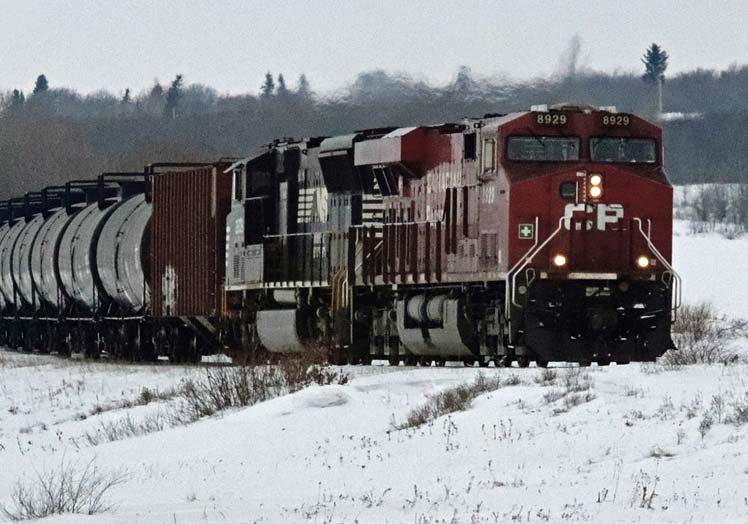

Own Delivery Targets
Canada - There are many factors that can affect how quickly harvested grain moves from a remote farm location in Western Canada to an
outbound ocean vessel on Canada's West Coast.
According to sources in the grain industry, the main factors behind this year's shipment delays aren't much different than usual, bad weather and bad industry
guidance.
In a recent conversation with The Western Producer, one prairie producer lamented the fact that railways often point to frigid temperatures and challenging
winter conditions as the root cause behind reduced fluidity in the grain handling system.
"Using winter as an excuse doesn't cut it anymore," said the farmer, who asked that his identity be protected.
"That explanation is getting very old."
Like it or not, weather plays a significant role in determining how quickly things get done, both on the farm and in the grain supply chain.
Canadian Pacific Railway (CP) reminded shippers of this fact in early March.
"Recently we have experienced unprecedented cold, 60 percent colder, 78 percent more days below -25 C, and snow along with some significant
outages," CP said in a recent news release.
"While extreme weather took its toll on the entire supply chain through much of February, CP's network is now starting to recover," it
said.
"Week 31 saw grain shipments increase by 16 percent week-over-week, and each day CP's network is getting more fluid.
CP also spotted nearly 50 percent more empties to the country in Week 31 compared to the week prior, a further sign of the incremental gains being
made."
Industry guidance is another issue that can affect grain delivery opportunities, especially when guidance offered by rail companies deviates significantly from
actual performance.
"The most important factor is the actual supply of cars compared to the guidance given by the railways," said Quorum Corp. president Mark Hemmes, who
oversees the federally commissioned Grain Monitoring Program.
"That seems to go missing in the public discussions, but it is at the core of why the industry is so upset."
In a recent email to The Western Producer, Hemmes provided a general explanation of how Canadian grain companies plan their sales and shipping
programs.
The foundation of every grain company's plan is an accurate understanding of how many empty hopper cars they can realistically expect to receive, he
said.
"Grain companies will plan their sales programs on the basis of what their historical share has been of the total rail car allocation, everything moves
forward from there," Hemmes said.
"Sales contracts are made with buyers, contracts are signed with shipping lines for vessels, and forward contracts with producers are established to
support the sales made."
This year, car allocation plans, particularly on the Canadian National Railway (CN) network, fell well short of projections, even before winter weather became
a significant factor.
According to Hemmes, the whole of the system started to backlog in September "as CN fell behind in meeting their own guidance levels."
Scheduled grain deliveries in the country fell even further behind in late January and February, when winter conditions worsened and train movements
slowed.
The fact that CN failed to live up to its own car allocation projections is no secret.
Earlier this month, CN announced the sudden resignation of its top executive, Luc Jobin.
Jobin's resignation coincided with a growing chorus of complaints from shippers in the Canadian grain industry.
That was followed by a public apology from Jobin's interim replacement, J.J. Ruest, who said the company will quickly improve the movement of western Canadian
grain and is directing additional people and equipment to clear backlogs across its network.
"We apologize for not meeting the expectations of our grain customers, nor our own high standards," Ruest said in a 7 Mar 2018 news
release.
So how much did CN's car allocation performance deviate from the company's car allocation projections?
That depends on who you speak to.
Kate Fenske, CN's manager of media relations, public and government affairs for Western Canada, said CN provided guidance of 5,500 hopper car placements per
week for the first 17 weeks of the 2017-2018 crop year, followed by 4,000 cars per week during the dead of the Western Canadian winter.
"The weekly sustainable supply chain capacity, as it relates to the deployment of CN's common hopper fleet, is 5,500 cars per week," Fenske wrote in
a 7 Mar 2018 email.
"This sustainable capacity reduces to an average 4,000 cars per week between grain weeks 18 to 35, on account of the lost throughput at Thunder Bay and
normal winter operating conditions," she continued.
If winter is particularly mild and the supply chain is unusually fluid, as it was during the 2016-2017 crop year, the rail component of the supply chain is
able to exceed these levels and flow more grain through the system, she added.
Fenske said total bulk grain movements on CN's network as of late February was just four percent below the company's previous three-year average.
"Through this winter, we are averaging 3,973 cars. In February, our average was 3,400 or about 85 percent of the 4,000 plan," she said.
During the first week of March, CN delivered 4,577 empty hopper cars, she added.
That's 35 percent more than the company's weekly February average and 577 cars more than CN's "winter maximum sustainable supply chain
capacity."
The Grain Monitoring Program's figures offer a different perspective.
"Based on their own reports, between Week 7 and Week 20, there were only two weeks where CN actually supplied 5,500 cars," Hemmes told The Western
Producer.
"And from Week 21 to Week 29 there was only one week where they supplied 4,000 cars."
Some observers also pointed to annual crop production estimates as another fly in the ointment.
According to CP, initial estimates for western Canadian crop production were nearly 10 percent lower than actual production.
Does that also qualify as poor industry guidance?
"CP strategically plans each year for the upcoming crop, which this year was originally forecast around 65 million metric tonnes, but will end up being
closer to 71 million metric tonnes, close to a 10 percent difference," the company said.
Collectively, the various partners in the Canadian grain supply chain need to answer some important questions:
- For a Canadian grain industry that demands more space each year on a rail system that offers finite capacity, is it reasonable to expect more accuracy
from annual crop production estimates?;
- For a Canadian rail industry that continues to report record revenues and profits each year, is it reasonable for shippers to expect that a certain
percentage of grain freight revenues might be spent each year on expanding network capacity?;
- And for farmers who dream of a system that offers guaranteed delivery opportunities within an acceptable timeframe, is it reasonable to assume that the passage of Bill C-49 and the use of reciprocal monetary penalties between grain companies and railways will result in better delivery opportunities for farmers?
Probably not, says the National Farmers Union.
As the lowest cog in the prairie supply chain, grain farmers have little to gain from legislation that facilitates more detailed contracts between grain
companies and railways, entities that already hold all the trump cards.
"Unfortunately, too many farm groups, along with the federal and some provincial governments, believe in the fallacy that reciprocal penalties between
railways and grain companies will cure many of our problems," said Terry Boehm, a Saskatchewan grain farmer and former president of the NFU.
"What we have in Bill C-49 is a set of tepid and harmful amendments to the Canada Transportation Act that refuse to recognize the real power dynamics that
exist in a system where most grain delivery points are captive to one railway or another."
"A system of reciprocal penalties for non-performance by grain companies and railways could prove useless for improving service or reducing costs for
farmers," added farmer Cam Goff of Hanley, Saskatchewan, also an NFU member.
"Grain companies are unlikely to pass any savings on to farmers since costs they incur can be hidden in basis discounts on grain prices paid to farmers.
In fact, rail service may even get worse since the railways may decide to schedule fewer car drops unless they are certain they can supply
them."
Brian Cross.
under the provisions in
Section 29 of the Canadian
Copyright Modernization Act.

